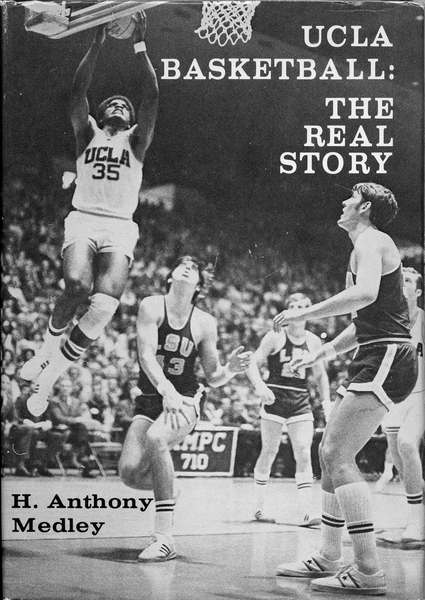|
Out of print for more than 30 years, now available for the first time as an eBook, this is the controversial story of John Wooden's first 25 years and first 8 NCAA Championships as UCLA Head Basketball Coach. This is the only book that gives a true picture of the character of John Wooden and the influence of his assistant, Jerry Norman, whose contributions Wooden ignored and tried to bury. Compiled with more than 40 hours of interviews with Coach Wooden, learn about the man behind the coach. The players tell their their stories in their own words. Click the book to read the first chapter and for ordering information. Also available on Kindle. |
|
Liberal Arts (8/10) by Tony Medley Runtime 97 minutes. OK for children. For some reason, I sometimes fight a movie when it starts. Maybe it's because while I subconsciously realize that the movie strikes a good note, I'm dubious that it's really doing what I think it might be doing. That's the way it was with this one. I was fighting it for the first 45 minutes. However, once I relaxed I got into it. This movie reminds me so much of a young Albert Brooks movie (which includes 1985's Lost in America, which is one of the best and funniest Indies ever made). Although not as funny as Brooks at his best, this is deep and complex. Like Albert, this is an auteur performance by Josh Radnor, who wrote, directed, and starred in the film. He has an appealing presence, with an easy smile and projects an immense likeability. As a 35-year-old graduate of an unnamed Midwestern college, Jesse (Radnor), who has just been dumped by significant other (interestingly, she is never identified as his wife), is invited back to his alma mater by his favored English professor, Peter Hoberg (Richard Jenkins, in another one of his trademark fine performances), to attend Peter's retirement party. There he meets 19-year-old Zibby (Elizabeth Olsen), with whom he quickly develops sparks, much to the sensitive Jesse's dismay as he has a hard time coming to grips with the 16 year disparity in their ages. What follows is a tender comedy of morals, rare to today's films, with terrific dialogue. Olsen is a beautiful actress who gives a wonderful performance, capturing her character's youthful, devil-may-care pseudo-sophistication along with her inexperience and sensitivity. Adding charm to the movie is that it was shot on location at Radnor's alma mater, Kenyon College, an impossibly picturesque Ohio location with tree-lined walkways, comfy dormitories, and delightful white brick buildings. Zac Efron gives a memorable performance as a weird guy who appears on campus occasionally whose only purpose in life seems to be to make Jesse looser and enable him to have more fun. Efron looks like a homeless person but he's so upbeat that the screen lights up whenever he appears. The way he moves his body and hands is magical.
Adding charm to the movie is that it was shot on location at Radnor's alma mater, Kenyon College, an impossibly picturesque Ohio location with tree-lined walkways, comfy dormitories, and delightful white brick buildings. There is, however, one scene that either contains an unforgivable faux pas, or is an extremely subtle jab at the hypocrisy of self-deluding intellectual professors. One of Jesse's revered Romantics professors (Allison Janney) is a cold, unhappy woman and she's putting him down. He says something along the lines of "It's depressing to learn this about a professor I took English from," and she immediately corrects him that the correct grammar is "from whom I took English." He then replies something along the lines about what kind of person she seems to be and she replies, "Yes, that is me." Anybody who is such a purist that she won't accept a terminal preposition (as am I, incidentally), would know that in traditional English the verb "to be" takes the nominative case, not the objective, and her reply should be "Yes, that is I," not "…that is me." It is true, however, that colloquial usage has resulted in many grammarians accepting "that is me" in ordinary conversation. While it may sound insufferably pretentious to say "that is I," since Janney's character is, in fact, insufferably pretentious, as a purist who would correct Jessie about his terminal preposition, she would never consider saying in her next breath, "that is me." Since she says it in such a matter of fact way, though, and since it is not made an issue, I can't help but think that Radnor wrote it that way simply because he really doesn't know correct grammar (nor, apparently, does anybody else on the production team). If it is a subtle jab, it is too understated to be effective. Whew! That was like Tom Sawyer painting his fence. Once I got into it, I couldn't stop until it was finished. Another problem I had with the film was that it was far too loud at my screening. After the screening I spoke with the projectionist and asked him about the volume. He said he usually runs films at a 7 and that he actually ran this at a 6.5, so there could be something wrong with the audio. But those are minor complaints that as a critic I'm duty-bound to report. They certainly don't destroy a wonderful movie. September 4, 2012 |
|
|
